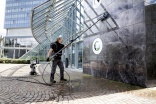Home › magazine › special features › Thoroughly modern window cleaning
Thoroughly modern window cleaning
15th of August 2024Technology is having a huge influence on every area of our lives. It has even entered the traditional world of window-cleaning. But how far are modern window cleaning systems such as cobots, drones and other high-tech systems changing the face of the industry, asks Ann Laffeaty.
The task of window cleaning used to be a relatively simple one that required a ladder, detergent, water, a squeegee and an operator – and little else. But as in every other industry today, technology has been slowly creeping into the sector. And in many cases it is having a positive effect on operations since it is helping to enhance cleaning performance and improve safety.
But does this mean we are experiencing a revolution in window cleaning? Or are the more traditional methods and equipment used throughout the generations still favoured by most operatives?
Unger’s marketing communications specialist Chiara Pick believes automated systems are helping to make the window cleaner’s work easier, safer and more efficient. “Technological progress is a huge opportunity for the cleaning sector and as with most other industries, ours is intensively engaged with the challenges and opportunities it offers,” she said.
Automated systems have already proved their worth in certain window cleaning applications, she says. “Currently they are primarily being used on large, horizontal surfaces and in areas that are difficult to access such as solar panels and ships,” said Pick.
“However, they are still a relatively niche application when it comes to regular buildings. Few professionals would use a drone to clean one of those because it would entail cordoning off and securing the entire area to avoid any risk to people. And this would require too much effort.”
She says Unger is constantly working on solutions that achieve optimum results while also making the window cleaning task easier, safer and more efficient. The company uses intelligent technology for its automated pure water-production system which is said to extend running times, minimise maintenance and reduce costs.
Manual systems still work best in most residential and commercial buildings, according to Pick. “Automated systems cannot yet replace traditional window cleaning methods for the vast majority of the market,” she said.
The window cleaning sector is coming up against new issues as it evolves, says Kärcher’s product management jetting solutions Steffen Burger. “Modern architecture creates individual challenges that require specific solutions,” he said. “With photovoltaic systems, for example, there was an initial assumption that cleaning and maintenance were unnecessary due to the so-called lotus effect. However, it has become clear weather conditions and air pollution can leave their mark.”
Weather factors
New weather challenges are complicating the task of glass cleaning, he says. “Sand from the Sahara recently settled all over Europe, impeding the view from windows while also having a major impact on the efficiency of solar panel systems,” he said. “This type of weather phenomenon has become more and more frequent in recent years.”
He claims the efficiency of photovoltaic panels can be increased by up to 30 per cent through regular cleaning using the right equipment. And he says there has been a growing call for autonomous cleaning solutions for use on solar panels and large window façades as a result.
“While many companies are seeking innovative methods that involve employing robots or drones for window fronts and glass facades, these are expected to significantly reduce the total cost of ownership in the future,” he said. “As it stands, employees are still always required on site for safety reasons.”
Kärcher’s window cleaning range includes high-pressure accessories such as rotating roller heads, fixed brushes, multi-purpose telescopic lances and adapter sets to an ergonomic carrier system. Brushes are available in three hardness classes – soft, medium and hard –and can be fitted without the need for tools.
Moerman’s chief marketing guardian Kelly Raeds claims to have noticed a recent increase in demand for automated systems. “There is definitely a push towards these for high-rise and hazardous jobs due to their ability to significantly reduce safety risks,” she said. “However, their widespread adoption is still a work in progress.
“While these advancements are noteworthy, it would be premature to label them as revolutionary within the window cleaning sector because their effectiveness is contingent upon favourable weather conditions. And their use can primarily only be justified in larger-scale projects.”
She claims the tried-and-tested traditional methods remain indispensable, particularly for residential and smaller commercial buildings where attention to detail is paramount. “After all, clean windows can not only enhance the aesthetics of a building, they will also speak volumes about the professionalism of an establishment,” she said.
While not a specialist in high-tech window equipment, Moerman has introduced some recent innovations such as the Liquidator 3.0 channel which is said to eliminate the need for towel detailing, and the Excelerator 2.0 handle which is described as having an ergonomic design.
Automated systems are not yet being widely used in the window cleaning industry, says Principle Cleaning services managing director David Saville. However, he adds that there are clear signs of progress. “The automated cleaning of horizontal surfaces – and solar panels in particular – is increasingly being carried out because the equipment can be controlled more easily and the need to work from height is eliminated,” he said.
“There is also a growing interest in robotics for high-rise work with at least two systems currently emerging. So we can be optimistic that robotics will be with us soon and will be much more commonplace in a few years’ time.”
Small-scale robotics
He says robotics are currently being used on a smaller scale for tasks such as cleaning hard-to-reach windows. “However, it is important that any equipment is well controlled and that it cannot become detached and fall, since this would cause damage to surfaces and could potentially harm anyone down below.”
Cobots, drones and other automated systems are not yet being used at any significant level in the commercial sector, says Saville. “As a result, they are not yet revolutionising the industry - although who knows what is to come?” he said. “In all likelihood we will see some development where robotics are pre-installed as part of new buildings and projects, although this will require some vision from architects and developers.”
Principle is currently exploring a partnership with Skyline Robotics to employ the Ozmo, an automated window washing machine first used in New York. This uses hyperspectral cameras to assess the condition of a façade and is said to increase productivity, offer safety benefits and reduce carbon footprint.
The use of technology in the window cleaning sector is only likely to grow in the future, according to Saville. “This will particularly be the case around data collection which means work-recording will become more extensive,” he said.
“Technology is also likely to develop as a whole alongside the rest of the workplace and be combined with other factors, particularly in new builds where it can be designed in.
“However, the various access and design challenges encountered in window cleaning require the versatility and adaptability of hands-on cleaning. So I think there is likely to be a place for traditional window cleaning for a long time to come.”
Do other commentators agree with this view? Unger’s Chiara Pick believes that even the newest systems will never function autonomously. “Qualified personnel will be needed to control and monitor their use,” she said. “So, window cleaning that works entirely without people will remain a utopia.”
Safety issues
Kärcher’s Steffen Burger concurs. “We do not anticipate seeing fully automated cleaning systems on the window cleaning market in the near future due to safety issues,” he said. “Modern methods using water-fed poles have come to play a major role and represent a cost-effective method in the window cleaning business. But we still see a lot of classical cleaning still being carried out with a window squeegee and a washer.”
And Moerman’s Kelly Raeds adds: “While technology has its place, there is a timeless appeal to reliable tools that get the job done right.”










